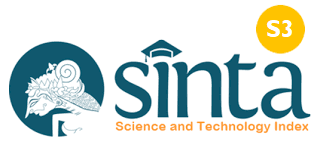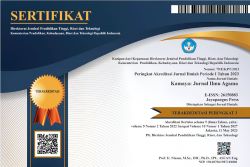Islamic Therapeutic Comunication Techniques of the Health Departement In Addressing Stunting in Serdang Bedagai Regency
DOI:
https://doi.org/10.37329/kamaya.v8i1.3959Keywords:
Communication, Therapeutic, StuntingAbstract
Therapeutic communication is a form of communication that focuses on helping individuals overcome problems and achieve holistic well-being, including physical, emotional, and spiritual aspects. This study aims to explore Islamic therapeutic communication techniques applied by the Serdang Bedagai District Health Office in dealing with stunting problems. The research approach uses a qualitative method with data collection through interviews, observations, and documentation. Data sources consist of primary data, namely direct information from informants, and secondary data in the form of supporting documents. In dealing with stunting, the Serdang Bedagai District Health Office makes various efforts, such as providing education and understanding to the community. The goal is to strengthen the relationship between the health center and the local community. The forms of communication applied include interpersonal conversations and dialogues that are open and comfortable. This creates a sense of mutual trust between the community and the Health Office. The Islamic therapeutic communication techniques applied include verbal communication, such as the use of calming and empathetic words, and nonverbal communication, such as body language and supportive facial expressions. The conclusion of this study shows that Islamic therapeutic communication techniques play an important role in helping patients overcome health problems, especially stunting. Comfortable, open, and Islamic communication not only improves good relations between health workers and the community but also has a positive impact in supporting health programs in the area. This reflects a holistic approach that prioritizes the physical, emotional, and spiritual needs of patients.
References
Afifah, I. (2019). Kinerja Kader dalam Pencegahan Stunting: Peran Lama Kerja Sebagai Kader, Pengetahuan dan Motivasi. Kedokteran Brawijaya, 30(4).
Arifin, M. Z. (2023). Terapi Spiritual, Komunikasi Merawat Pasien. Klaten: Lakeisha.
Arindita, M. S., Raykhani, M. A., Ra’uf, N., Ardianoor, R., & Suharyat, Y. (2022). Prinsip Dasar Ilmu Komunikasi Islam. Religion: Jurnal Agama, Sosial, Dan Budaya, 1(5), 12-25.
Aristasari T, Afifah A, Hakim M, D. dan S. T. (2018). 1000 Hari Pertama Kehidupan. Yogyakarta: Gadjah Mada University Press.
Atmaka DR, Wisnusanti SU, W. M. dan H. S. (2019). Stunting: Permasalahan dan Penanganannya. Yogyakarta: Gadjah Mada University Press.
Beekun, R. I. dan. (2004). Etika Bisnis Islam. Yogyakarta: Pustaka Pelajar.
Chichi Hafifa Transyah dan Jerman Toni. (2018). Hubungan Penerapan Komunikasi Terapeutik Perawat dengan Kepuasan Pasien. Endurance, 2(1).
Devito, J. A. (1997). Komunikasi Antar Manusia. Terjemahan Agus Maulana. Jakarta: Profesional Books.
Farida, D. (2024). Penerapan Konseling Individu Dengan Komunikasi Terapeutik Islami Dalam Meningkatkan Kepercayaan Diri Siswa. Al- Ittizan, 7(2).
Gresia Nindri Ariany Tamonob. (2023). Komunikasi Terapeutik Dalam Penangan Pasien Dengan Gangguan Kejiwaan (Studi Kasus Pada RSJ Naimata). Delibaratio, 3(1).
Guire, M. B. M. (2002). The Social Contex. California. California: Wadsworth Publishing Company Fifth Edition.
Gusti Devi Rizki Mahmudah. (2022). Komunikasi Terapeutik Tenaga Kesehatan Dalam Meningkatkan Kualitas Pelayanan. Journal Dunia Komunikasi Prodi Ilmu Komunikasi, 10(4).
Haryono, C. G. (2020). Ragam Metode Penelitian Kualitatif Komunikasi (1st ed.; D. E. Restiani, ed.). Sukabumi: CV. Jejak.
Ibin Hasani. (2018). Komunikasi Terapeutik Perawat Rohani Islam dalam Proses Penyembuhan Pasien di RSUD Ciamis. Communicatus: Jurnal Ilmu Komunikasi, 2(2).
Lia Agustin, & D. R. (2021). (2021). Hubungan Pendapatan Keluarga Dengan Kejadian Stunting. Indonesian Journal of Midwifery, 4(1), 30–34. http://jurnal.unw.ac.id/index.php/ijm. Indonesian Journal of Midwifery, 4(1).
Madome, A. dan. (2020). Strategi Komunikasi Kesehatan Bagi Tingkat Kepatuhan Pasien Instalasi Rehabilitasi Medis RSUP Prof. Kandou Manado. Komunikologi, 4(2).
Mayasari D, I. dan S. (2018). Stunting, Faktor Resiko dan Pencegahannya. J Agromedicine, 5(1).
Muhith, A. (2018). Aplikasi Komunikasi Terapeutik Nursing & Health. Yogyakarta: CV Andi Offset.
N, I. (2020). Stunting pada Anak: Kenali dan Cegah Sejak Dini. Yogyakarta: Hijaz Pustaka Mandiri.
Novita, R. (2020). Hubungan Pelaksanan Komunikasi Terapeutik Dengan Tingkat Kecemasan Pasien Rawat Inap. Jurnal Keperawatan Profesional (JKP), 8(2).
Priyanto, A. (2009). Komunikasi dan Konseling Aplikasi Dalam Sarana Pelayanan Kesehatan Untuk Perawat dan Bidan. Jakarta: Salemba Medika.
Rakhmat, J. (2001). Psikologi Komunikasi. Bandung: PT.Remaja Rosda Karya.
Rosa Apriliyanti. (2021). Komunikasi Terapeutik Perawat untuk Meningkatkan Konsep Diri Pasien Skizofrenia. Jurnal Ilmu Komunikasi, 19(1).
Saefullah, U. (2007). Kapita Selekta Komunikasi: Pendekatan Budaya dan Agama. Bandung: Simbiosa Rekatama Media.
Sitorus, P. (2024). Hubungan Komunikasi Teraupetik Perawat Dengan Tingkat Kepuasan Pasien. Nursing Aplied Journal, 2(1).
Sukma, I. T. (2019). Strategi komunikasi Dinas Kesehatan Kabupaten Karanganyar dalam menekan angka stunting (Skripsi, Universitas Sebelas Maret).
Suryani. (2005). Komunikasi Terapeutik; Teori dan Praktik. Jakarta: EGC.
Wulur, M. B. (2021). Penerapan Komunikasi Efektif Berbasis Islam Dalam Pengembangan Karir. Jurnal J-BKPI, 1(1).
Zuliana Sari. (2024). Membangun Hubungan yang Positif melalui Komunikasi yang Efektif. KHIRANI, 2(4).
Downloads
Published
How to Cite
Issue
Section
License
Copyright (c) 2025 Kamaya: Jurnal Ilmu Agama

This work is licensed under a Creative Commons Attribution-ShareAlike 4.0 International License.
An author who publishes in the Kamaya : Jurnal Ilmu Agama agrees to the following terms:
- Author retains the copyright and grants the journal the right of first publication of the work simultaneously licensed under the Creative Commons Attribution-ShareAlike 4.0 License that allows others to share the work with an acknowledgement of the work's authorship and initial publication in this journal
- Author is able to enter into separate, additional contractual arrangements for the non-exclusive distribution of the journal's published version of the work (e.g., post it to an institutional repository or publish it in a book) with the acknowledgement of its initial publication in this journal.
- Author is permitted and encouraged to post his/her work online (e.g., in institutional repositories or on their website) prior to and during the submission process, as it can lead to productive exchanges, as well as earlier and greater citation of the published work (See The Effect of Open Access).
Read more about the Creative Commons Attribution-ShareAlike 4.0 Licence here: https://creativecommons.org/licenses/by-sa/4.0/.





